Hygienic shower: the main elements of the design, typical
Hygienic shower is a sanitary device, which is used for the care of intimate places after using the toilet. This device has a significant list of advantages, because recently the installation of a hygienic shower in the bathroom has become very popular.
Below we will tell you what are the advantages of using such a system, how to choose a shower for home use and how to install it correctly.

The use of hygienic soul in terms of medicine
Intimate hygiene shower is a device that is rarely used in our country. Usually in the toilets of our apartments you can find either a sink for washing hands or a bidet. And this is at best, because small-sized bathrooms allow you to place in them except a bucket for used toilet paper.
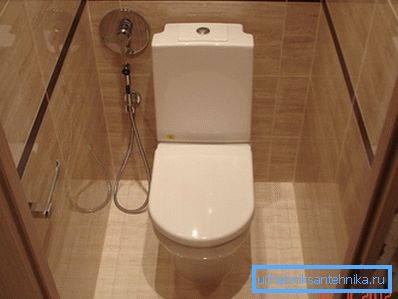
At the same time, in Europe, and even more so in the countries of the Middle East, where Islam is the predominant religion with its extremely strict hygiene requirements, finding a comfortable toilet without a shower head is quite difficult.
The choice of such a device is justified from a medical point of view:
- First, the stream of water from the shower allows you to carry out all the necessary procedures after the toilet much more efficiently than toilet paper. (even the highest quality).
- Secondly, this treatment is much more hygienic., since all sewage is immediately washed down the toilet.
- And thirdly, the effect of the shower on the skin stimulates the blood flow in it and acts as an improvised massage.. As medical statistics show, people who use such a device, hemorrhoids, proctitis, erosion of the rectum and other diseases of this kind are noted much less frequently.
- In addition, the standard hose for the hygienic shower 1 meter in length allows for a variety of manipulations. and when cleaning the toilet bowl, and when cleaning children's nursery pots, and when caring for cat trays.
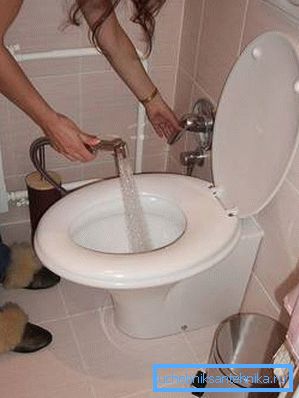
We hope that after all the above questions about why you need a hygienic shower, you will not have. So if the dimensions of the bathroom do not allow you to install a bidet, then you may well consider the possibility of installing just such a device.
Selection and installation
Basic construction elements
To understand what kind of hygienic shower to choose, you need to understand what it consists of and what its parts are experiencing the maximum operational load.
There are many varieties of such devices on the market (we will analyze their differences in the next section), but almost all of them are assembled from typical elements:
- The hygienic shower watering canister is the main detail that provides not only the dissection of the water jet into many small streams, but also allows you to turn the shower on and off and also control its pressure. To do this, on the handle of the watering can is installed a shut-off valve, controlled by pressing a hand.
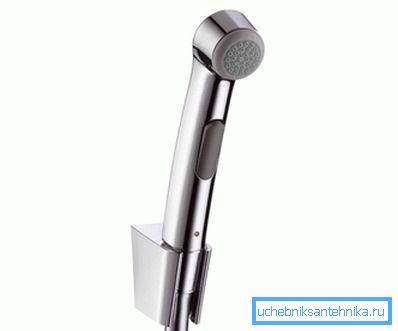
Note! In some models, as well as in ordinary shower watering cans, the configuration of the flow of water is also regulated, starting from a single dense jet and ending with a sprinkler mode.
- Hose - flexible pipe length from 1 to 2 meters. Typically, these devices are available with rubber hoses in a protective metal sheath; You can also find plastic hoses. As a rule, the price of metal braided hoses is somewhat higher.
- Fittings to connect. Used to connect the shower to the water supply outlet. The ideal option is to connect through a faucet with a thermostat: this way we will be able to perform all hygiene procedures using water at the optimum temperature.
- In addition, usually a set of hygienic shower includes various fixtures for fixing a watering can, as well as nozzles and adapters necessary for mounting the product.

As for the material, most products of this type are made of stainless steel with chrome or nickel coating. In the economy segment, you can find silumin models that are inferior to steel in strength. If you want to buy the highest quality device, then get a hygienic bronze shower: it is quite expensive, but it does not wear out with time and does not corrode.

Typical product types
Depending on the type of construction, there are several types of shower heads for intimate hygiene. Choose the one that best suits your conditions, you can in the table below:
| Variety | Features of construction and connection |
| Wall |
|
| Mounted on the sink |
|
| With mounting on the tank |
|

Strictly speaking, not only the answer to the question of how to use a sanitary shower, but also the method of its installation depends on the type of device used. Below we will describe how the wall-mounted version is installed, since it is the simplest, and you will definitely cope with it without the help of specialists.
Mounting technique

To install a hygienic shower, we need to make changes to the pipe layout. That is why it is worth starting work during a major overhaul - this is how we will be able to provide hidden laying of water supply circuits without damage to the bathroom.
We perform works as advised by the instruction:
- In the wall we make the grooves in which we lay bends from pipes with hot and cold water.
Tip! By tradition, such devices are mounted under the left arm, but you can install the shower on the right.
- On a capital basis, we fix the bar with the installed pipe ends.
- Fill in the wall tiles and finish the wall with ceramic tiles or other decorative materials.
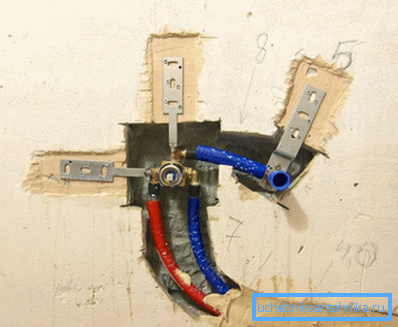
- We connect a thermostatic mixer to the limit switches. Tighten the nuts one turn at a time alternately, preventing the mixer from tilting.
- To the conclusion of the mixer we attach the hose of the hygienic shower.
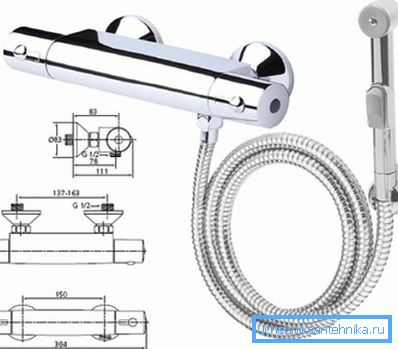
- Using a drill with a drill on the tile, we make a hole into which we insert a plastic dowel. With the help of the screw fix the holder for the watering can on the surface.
- Watering can be attached to the hose, controlling the position of the sealing gasket.
- We check the operation of the system by opening the hot and cold water taps on the risers.
- We adjust the thermostat, selecting the optimum water temperature.
As you can see, do-it-yourself installation of the system is not complicated, so you can install a shower on the prepared conclusions in just a few minutes.
Conclusion
The above tips on how to choose a hygienic shower and how to properly mount it, will be useful primarily to owners of close bathrooms that do not allow the installation of a bidet. However, even in a spacious toilet, such an adaptation would also not be superfluous, because the video in this article is worth studying anyway.